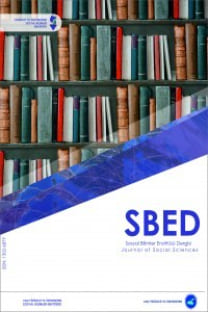Marcel Proust’un Romanlarında Zaman Oyunu
Marcel Proust modern romanın öncülerinden birisi olarak kabul edilmektedir. Proust romanlarında yeni bir teknik uygulamaya özen göstermiştir. Romanlarının ana temasını (izleğini) zaman sorunu oluşturmaktadır. Bu nedenledir ki yedi ciltten oluşan romanlarını Kayıp Zamanın İzinde (A la Recherche du Temps Perdu) başlığı altında toplamıştır. Farklı romanlardan oluşan yapıtının, kurgusal bağlamda birbirinin devamı şeklinde bir bütünlük oluşturduğu görülmektedir. Proust’un romanlarının genel başlığı, daha ilk bakışta okura yazarın zaman konusundaki düşüncesi ya da uğraşı hakkında ipucu vermektedir. Kayıp zamanını tekrar elde edebilme uğraşı içerisinde olan Proust, sürekli farklı oyunlar kurgulamaya çalışmaktadır. Dolayısıyla romanlarında sadece tema olarak geçmiş zamanın peşinde değil, aynı zamanda çeşitli geriye dönüş yöntemleri ile roman tekniği bağlamında da geçmiş zamanın arayışı içerisindedir. Türlü zaman oyunları ile sonsuzluğu elde etme peşinde olan yazarın yedi ciltlik romanını bir gecelik rüya ürünü olarak sunmaya çalıştığı görülmektedir. Zira ilk cilt bir rüya ile başlarken, son cilt de adeta bu rüyadan uyanma olarak değerlendirilebilmektedir. Rüya bir yandan geçmiş zamanlara dönme aracı iken, diğer yandan dünyadan küçük bir kopuş ve yeniden canlanmayı da sembolize etmektedir. Proust’un tüm romanları boyunca çeşitli yöntemleri deneyerek yapmaya çalıştığı, yeniden yaşamı elde etme, bir başka deyişle sonsuzluğu yakalama uğraşından başka bir şey değildir. Çalışma, doküman analizine dayalı nitel bir araştırmadır.
Anahtar Kelimeler:
Uzlaşma zamanı, psikolojik zaman, bölünmez zaman
The Play of Time in the Novels of Marcel Proust
Marcel Proust is regarded one of pioneers of the modern novel. Proust tries to implement a new technique. His novels’ main themes consist of timing problems. For this reason, he brings all the collections of 7 novels under one volume (A la Recherche du Temps Perdu). It is seen that the different novels are connected with each other in a set of series in a fictional context. His novels give a hint when one looks at the title regarding what the author thinks of “time”. Proust, trying to catch up the lost time, tries to fictionalize different plays. Therefore, he deals with not only the lost time as a theme but also together with various techniques, he looks for the past time as a novel technique. With different timing plays, trying to catch up eternity, the author tries to present his 7 volumes novels like a dream product. To put it differently, whereas the first volume starts with a dream, the last volume can be regarded as the awaking from this dream. Dream is a tool for going back to past time, on the other hand, it symbolizes resurrection as well. This study is a qualitative study using a document analysis.
___
- Albérès, R.-M. (1966). Métamorphoses du Roman. Paris: Editions Albin Michel.
- Bernard, D., Carbonell, A., Jabbour, N. ve Eichel-Lojkine, P., (1996). La Littérature Française au BAC. Paris : Belin.
- Delattre, F. (1948). Bergson et Proust, Accords et Dissonances. Paris: Editions Albin Michel.
- Deleuze, G. (1964). Marcel Proust et les Signes. Paris: Presses Universitaires de France.
- Doğan, Ş. (1980). Modern Roman Sanatında Zaman Kavramı Üzerine. Batı Edebiyatları Araştırma Dergisi, 3 (Bahar), 20-30.
- Emie, L. (1930). Marcel Proust Vu par un Allemand. Bulletin Marcel Proust, Défense de Marcel Proust, Paris: Le Rouge et Le Noir.
- Güngör, F.Ş. (2015). Marcel Proust’un Kayıp Zamanın İzinde Adlı Romanında Belleğin Kurgulayıcı Rolü Üzerine Bir Değerlendirme. Ankara Üniversitesi Dil ve Tarih-Coğrafya Fakültesi Dergisi, 55 (2), 59-74.
- Husson, R. (2018). The Concept of Love in Swann’s Way. Search of Marcel Proust, California: Scripps College and The Ward Ritchie Press.
- Kristeva, J. (1994). Le Temps Sensible, Proust et l’Expérience Littéraire. Paris: Gallimard.
- Lebon, S. (2016). Proust et l’Esthétique du Temps dans À la Recherche du Temps Perdu. Revista de Lenguas Modernas, 24, 43-61.
- Maurois, A. (1949). A la Recherche de Marcel Proust. Paris: Hachette.
- Nathan, J. (1953). La Morale de Proust. Paris: Librairie Nizet.
- Öner, H. (2014). Proust’un Zamana Karşı Zaferi: Kayıp Zamanın İzinde, Akademik Sosyal Araştırmalar Dergisi / ASOS, 2 (2), 183-188.
- Poulet, G. (1949). Etudes sur le Temps Humain. Paris: Plon.
- Proust, M. (2001a). Yakalanan Zaman. Hakmen, R. (Çev.). İstanbul: Yapı Kredi Yayınları.
- Proust, M. (2001b). Mahpus. Hakmen, R. (Çev.). İstanbul: Yapı Kredi Yayınları.
- Proust, M. (2000). Swann’ların Tarafı. Hakmen, R. (Çev.). İstanbul: Yapı Kredi Yayınları.
- Proust, M. (1997). Sodom ve Gomorra. Hakmen, R. (Çev.). İstanbul: Yapı Kredi Yayınları.
- Proust, M. (1993). Les Plaisirs et les Jours. Paris: Gallimard.
- Proust, M. (1943). Chroniques, Paris: Gallimard.
- Ricardou, J. (1967). Problèmes du Nouveau Roman. Paris: Editions du Seuil.
- Suixiang, C. (2009). Une Réflexion Sommaire sur le Temps de Proust. Synergies Chine, 4, 89-96.
- Şen, M. (1989). La Jalousie de Robbe-Grillet et la Nouvelle Technique Romanesque. Konya: Selçuk Üniversitesi Yayınları.
- Tadié, J-Y. (1971). Proust et le Temps. Paris: Galllimard.
- Tadié, J-Y. (1999). Proust: la Cathédrale du Temps. Paris: Galllimard.
- Tauman, L. (1949). Marcel Proust, une Vie et une Synthèse. Paris: Librairie Albin Colin.
- ISSN: 1302-6879
- Başlangıç: 2000
- Yayıncı: Yüzüncü Yıl Üniversitesi Sosyal Bilimler Enstitüsü Müdürlüğü
Sayıdaki Diğer Makaleler
Türk Bankacılık Sektöründe Yoğunlaşma
Alpaslan SEREL, Nurcihan AKŞEHİRLİ
Marcel Proust’un Romanlarında Zaman Oyunu
Sağbetullah MERİÇ, Öznur TURAY
Gazneliler Hanedanlığı’nda Bir Vefa Örneği: Buğracık b. Cûk/Karabeckem
Arapçada Bedel ve Atf-ı Beyân Kavramlarının Tanımı, Çeşitleri ve Aralarındaki Fonksiyonel Farklar
Hatıralarla Milli Mücadele’de Urfa
Carson McCullers’ ın Yalnız Bir Avcıdır Yürek Eserindeki Sessiz Etkileşim
Yeşil Alan ve Fiziksel Aktivitenin İnsan mutluluğu Üzerindeki Etkisinin Saptanmasında Bir Yöntem
